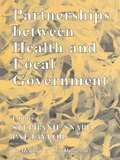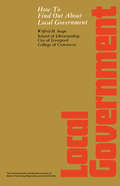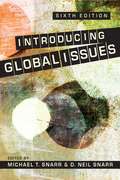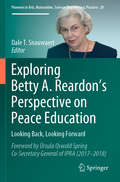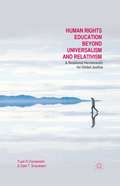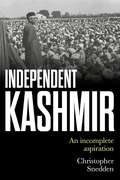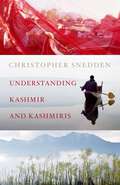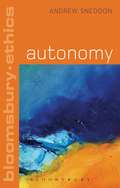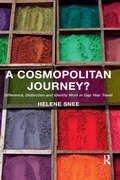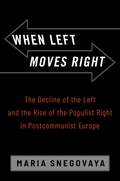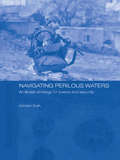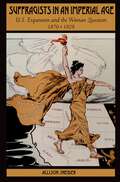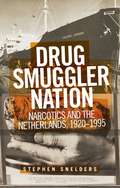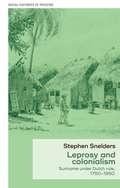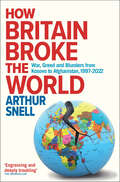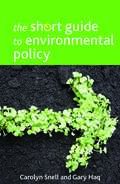- Table View
- List View
Partnerships Between Health and Local Government
by Stephanie Snape Pat TaylorThe theme of this collection of essays is partnerships between health and local government. Such partnerships are not new. Nor is discussion of the merits (or otherwise) of collaboration between the two sectors. The history of collaboration between these two sectors of the public services has been chequered to say the least; indeed, the boundary between health and social care has been described as a 'Berlin Wall'.However, New Labour's ascension to power in 1997 has rekindled an avid interest in this issue. The government's emphasis on partnerships and collaboration has been projected as a key element of its 'Third Way' philosophy. Partnership working in particular has been viewed as the most appropriate means of addressing endemic, obdurate social ills, such as social exclusion, poor health, poverty, and low educational standards.
How to Find Out About Local Government: The Commonwealth and International Library: Libraries and Technical Information Division
by Wilfrid H. SnapeHow to Find Out About Local Government is a guide to sources of information on local government in Britain, including libraries and record offices, public relations and information bureaux, and societies and institutions. Other sources covered in this monograph are education and training facilities, research, books and documents, periodicals, manuscripts and records, and audiovisual materials such as films, radio, and television. This book consists of 11 chapters and opens with an overview of local government in Britain, followed by a discussion on libraries and record offices as sources of local government information. The reader is then introduced to other information sources, including public relations and information bureaux, societies and institutions, books and documents, periodicals, manuscripts and records, and audiovisual sources. Sources of information on local government in Scotland are also considered, including yearbooks. Finally, published literature on comparative local government is evaluated. This guide will be a useful resource for political scientists, politicians, and local government officials as well as the general public interested in local government.
Introducing Global Issues (6th Edition) (PDF)
by Michael Snarr D. SnarrHow is new technology - cyberwarfare, drones, and more - affecting global security? Are the 2015 Sustainable Development Goals having an impact What progress are governments making in dealing with climate change? Is there a viable solution to the Syrian refugee crisis? How do we reconcile the concepts of universal human rights and national sovereignty? These are among the difficult questions addressed in this new, fully revised and updated edition of Introducing Global Issues. The material has been successfully designed for readers with little or no prior knowledge of the topics covered. Each chapter provides an analytical overview of the issue addressed, identifies central actors and perspectives, and outlines past progress and future prospects. Discussion questions are posed to enhance students' appreciation of the complexities involved, and suggestions for further reading additionally enrich the text.
Exploring Betty A. Reardon’s Perspective on Peace Education: Looking Back, Looking Forward (Pioneers in Arts, Humanities, Science, Engineering, Practice #20)
by Dale T. SnauwaertThis book presents commentaries by a leading international group of peace education scholars and practitioners concerning Reardon’s peace education theory and intellectual legacy. The guiding question throughout the book is: How can her foundational work be used to advance the theory and practice of peace education? In an attempt to find answers, the contributing authors explore three general areas of inquiry: (1) Theoretical Foundations of Peace and Human Rights Education; (2) Feminism and the Gender Perspective as Pathways of Transformation Toward Peace and Justice; and (3) Peace Education Pedagogy and Practices. A contemplative commentary by Reardon herself rounds out the coverage
Human Rights Education Beyond Universalism and Relativism: A Relational Hermeneutic for Global Justice
by Dale T. Snauwaert F. Al-DaraweeshThrough the preservation of the social, political, and cultural autonomies of peoples within diverse cultural contexts, Al-Daraweesh and Snauwaert propose a relational epistemology for human rights education.
Independent Kashmir: An incomplete aspiration
by Christopher SneddenMany disenchanted Kashmiris continue to demand independence or freedom from India. Written by a leading authority on Kashmir’s troubled past, this book revisits the topic of independence for the region (also known as Jammu and Kashmir, or J&K), and explores exactly why this aspiration has never been fulfilled. In a rare India-Pakistan agreement, they concur that neither J&K, nor any part of it, can be independent. Charting a complex history and intense geo-political rivalry from Maharaja Hari Singh’s leadership in the mid-1920s to the present, this book offers an essential insight into the disputes that have shaped the region. As tensions continue to rise following government-imposed COVID-19 lockdowns, Snedden asks a vital question: what might independence look like and just how realistic is this aspiration?
Independent Kashmir: An incomplete aspiration
by Christopher SneddenMany disenchanted Kashmiris continue to demand independence or freedom from India. Written by a leading authority on Kashmir’s troubled past, this book revisits the topic of independence for the region (also known as Jammu and Kashmir, or J&K), and explores exactly why this aspiration has never been fulfilled. In a rare India-Pakistan agreement, they concur that neither J&K, nor any part of it, can be independent. Charting a complex history and intense geo-political rivalry from Maharaja Hari Singh’s leadership in the mid-1920s to the present, this book offers an essential insight into the disputes that have shaped the region. As tensions continue to rise following government-imposed COVID-19 lockdowns, Snedden asks a vital question: what might independence look like and just how realistic is this aspiration?
Understanding Kashmir and Kashmiris
by Christopher SneddenIn 1846, the British created the state of Jammu and Kashmir (J&K) - popularly called "Kashmir" - and then quickly sold this prized region to the wily and powerful Raja, Gulab Singh. Intriguingly, had they retained it, the India-Pakistan dispute over possession of the state may never have arisen, but Britain's concerns lay elsewhere -- expansionist Russia, beguiling Tibet and unstable China "circling" J&K -- and their agents played the 'Great Game' in Afghanistan and 'Turkistan'. Snedden contextualizes the geo-strategic and historical circumstances surrounding the British decision to relinquish prestigious 'Kashmir', and explains how they and four Dogra maharajas consolidated and controlled J&K subsequently. He details what comprised this diverse princely state with distant borders and disunified peoples and explains the Maharaja of J&K's controversial accession to India on 26 October 1947 - and its unintended consequences. Snedden weaves a compelling narrative that frames the Kashmir dispute, explains why it continues, and assesses what it means politically and administratively for the divided peoples of J&K and their undecided futures.
Understanding Kashmir and Kashmiris
by Christopher SneddenIn 1846, the British created the state of Jammu and Kashmir (J&K) - popularly called "Kashmir" - and then quickly sold this prized region to the wily and powerful Raja, Gulab Singh. Intriguingly, had they retained it, the India-Pakistan dispute over possession of the state may never have arisen, but Britain's concerns lay elsewhere -- expansionist Russia, beguiling Tibet and unstable China "circling" J&K -- and their agents played the 'Great Game' in Afghanistan and 'Turkistan'. Snedden contextualizes the geo-strategic and historical circumstances surrounding the British decision to relinquish prestigious 'Kashmir', and explains how they and four Dogra maharajas consolidated and controlled J&K subsequently. He details what comprised this diverse princely state with distant borders and disunified peoples and explains the Maharaja of J&K's controversial accession to India on 26 October 1947 - and its unintended consequences. Snedden weaves a compelling narrative that frames the Kashmir dispute, explains why it continues, and assesses what it means politically and administratively for the divided peoples of J&K and their undecided futures.
Autonomy (Bloomsbury Ethics)
by Andrew SneddonPhilosophers have various reasons to be interested in individual autonomy. Individual self-rule is widely recognized to be important. But what, exactly, is autonomy? In what ways is it important? And just how important is it? This book introduces contemporary philosophical thought about the nature and significance of individual self-rule.Andrew Sneddon divides self-rule into autonomy of choice and autonomy of persons. Unlike most philosophical treatments of autonomy, Sneddon addresses empirical study of the psychology of action. The significance of autonomy is displayed in connection with such issues as paternalism, political liberalism, advertising and physician-assisted suicide. Sneddon both introduces the themes of contemporary autonomy studies and defends a novel account of its nature and significance. Autonomy is an ideal introduction for advanced-level undergraduate and postgraduate students to the issues and debates surrounding individual self-rule.
Autonomy (Bloomsbury Ethics)
by Andrew SneddonPhilosophers have various reasons to be interested in individual autonomy. Individual self-rule is widely recognized to be important. But what, exactly, is autonomy? In what ways is it important? And just how important is it? This book introduces contemporary philosophical thought about the nature and significance of individual self-rule.Andrew Sneddon divides self-rule into autonomy of choice and autonomy of persons. Unlike most philosophical treatments of autonomy, Sneddon addresses empirical study of the psychology of action. The significance of autonomy is displayed in connection with such issues as paternalism, political liberalism, advertising and physician-assisted suicide. Sneddon both introduces the themes of contemporary autonomy studies and defends a novel account of its nature and significance. Autonomy is an ideal introduction for advanced-level undergraduate and postgraduate students to the issues and debates surrounding individual self-rule.
A Cosmopolitan Journey?: Difference, Distinction and Identity Work in Gap Year Travel
by Helene SneeDoes travel broaden the mind? This book explores this question through an innovative sociological study of gap year travel. Taking a year out overseas between school and university is an increasingly legitimate practice for young people in the UK. But what do young people get out of gap years? A wide range of 'official' sources acknowledge gap years as a way of becoming a global citizen and more employable at the same time. Instead of automatically assuming that gap years are a 'good thing', this book critically considers how this contemporary rite of passage could contribute to the reproduction of structural disadvantage at both a national and international level in relation to young people's routes into education and employment, and representations of difference and distinction in cultural practices. The key argument running throughout the book is that well-established ways of thinking about and understanding the world are used to frame gap year experiences, including how other people and places are different; the influence of class in determining what has cultural value; and what sort of identity work is worthwhile. Gap years are located at a point where a number of fields overlap: education, employment and the consumption of leisure travel. A Cosmopolitan Journey? will therefore be of interest to students, academics and practitioners in these areas.
A Cosmopolitan Journey?: Difference, Distinction and Identity Work in Gap Year Travel
by Helene SneeDoes travel broaden the mind? This book explores this question through an innovative sociological study of gap year travel. Taking a year out overseas between school and university is an increasingly legitimate practice for young people in the UK. But what do young people get out of gap years? A wide range of 'official' sources acknowledge gap years as a way of becoming a global citizen and more employable at the same time. Instead of automatically assuming that gap years are a 'good thing', this book critically considers how this contemporary rite of passage could contribute to the reproduction of structural disadvantage at both a national and international level in relation to young people's routes into education and employment, and representations of difference and distinction in cultural practices. The key argument running throughout the book is that well-established ways of thinking about and understanding the world are used to frame gap year experiences, including how other people and places are different; the influence of class in determining what has cultural value; and what sort of identity work is worthwhile. Gap years are located at a point where a number of fields overlap: education, employment and the consumption of leisure travel. A Cosmopolitan Journey? will therefore be of interest to students, academics and practitioners in these areas.
When Left Moves Right: The Decline of the Left and the Rise of the Populist Right in Postcommunist Europe
by Maria SnegovayaOver the past two decades, postcommunist countries have witnessed a sudden shift in the electoral fortunes of their political parties: previously successful center-left parties suffered dramatic electoral defeats and disappeared from the political scene, while right-wing populist parties soared in popularity and came to power. This dynamic echoed similar processes in Western Europe and raises a question: Were these dynamics in any way connected? When Right Moves Left argues that they were. And that the root of the connection between them lies in the pro-market rebranding of the ex-communist left--the key explanatory variable. This book asserts that, though the left's pro-market shift initially led to electoral rewards, it had a less straightforward impact on left-wing parties' electoral fortunes in the long run. Traditional supporters of the left (working-class and economically vulnerable groups) were alienated by the new economic policies, and the middle-class voters newly drawn to these parties did not compensate for those losses. As a result, for several electoral rounds following the rebranding, reformist parties on the left suffered dramatic electoral defeats. In response, right-wing parties in their respective countries adopted more redistributive economic platforms consistent with preferences of former supporters of the left, and incorporated sizeable shares of these electorates. This contributed to the growth of right-wing populist parties in the countries with a pro-market left. The book traces this process in postcommunist Europe on different levels of analysis: cross-country observational data, case studies, and individual-level experimental surveys. It argues that scholars should incorporate the economic policy dimension when explaining the demise of the left and the rise of the populist right in the region. It also examines important parallels between the dynamics of Western and postcommunist countries by arguing that the idiosyncrasy of Eastern European politics has been overstated in scholarly literature.
When Left Moves Right: The Decline of the Left and the Rise of the Populist Right in Postcommunist Europe
by Maria SnegovayaOver the past two decades, postcommunist countries have witnessed a sudden shift in the electoral fortunes of their political parties: previously successful center-left parties suffered dramatic electoral defeats and disappeared from the political scene, while right-wing populist parties soared in popularity and came to power. This dynamic echoed similar processes in Western Europe and raises a question: Were these dynamics in any way connected? When Right Moves Left argues that they were. And that the root of the connection between them lies in the pro-market rebranding of the ex-communist left--the key explanatory variable. This book asserts that, though the left's pro-market shift initially led to electoral rewards, it had a less straightforward impact on left-wing parties' electoral fortunes in the long run. Traditional supporters of the left (working-class and economically vulnerable groups) were alienated by the new economic policies, and the middle-class voters newly drawn to these parties did not compensate for those losses. As a result, for several electoral rounds following the rebranding, reformist parties on the left suffered dramatic electoral defeats. In response, right-wing parties in their respective countries adopted more redistributive economic platforms consistent with preferences of former supporters of the left, and incorporated sizeable shares of these electorates. This contributed to the growth of right-wing populist parties in the countries with a pro-market left. The book traces this process in postcommunist Europe on different levels of analysis: cross-country observational data, case studies, and individual-level experimental surveys. It argues that scholars should incorporate the economic policy dimension when explaining the demise of the left and the rise of the populist right in the region. It also examines important parallels between the dynamics of Western and postcommunist countries by arguing that the idiosyncrasy of Eastern European politics has been overstated in scholarly literature.
Navigating Perilous Waters: An Israeli Strategy for Peace and Security (Israeli History, Politics and Society)
by Ephraim SnehIsrael is a Jewish state in a Muslim Middle East. How can it survive in that region? This book answers this question by analyzing the dangers and threats that Israel faces today. The book also highlights an important component of Israel's strength: the endurance and the cohesion of its social fabric, which the author sees as the key to his country's survival in the Middle East. Written by Israel's former deputy minister of defence, this book is essential reading for all those interested in the contemporary politics of the Middle East.
Navigating Perilous Waters: An Israeli Strategy for Peace and Security (Israeli History, Politics and Society)
by Ephraim SnehIsrael is a Jewish state in a Muslim Middle East. How can it survive in that region? This book answers this question by analyzing the dangers and threats that Israel faces today. The book also highlights an important component of Israel's strength: the endurance and the cohesion of its social fabric, which the author sees as the key to his country's survival in the Middle East. Written by Israel's former deputy minister of defence, this book is essential reading for all those interested in the contemporary politics of the Middle East.
Suffragists in an Imperial Age: U.S. Expansion and the Woman Question, 1870-1929
by Allison L. SneiderIn 1899, Carrie Chapman Catt, who succeeded Susan B. Anthony as head of the National American Women Suffrage Association, argued that it was the "duty" of U.S. women to help lift the inhabitants of its new island possessions up from "barbarism" to "civilization," a project that would presumably demonstrate the capacity of U.S. women for full citizenship and political rights. Catt, like many suffragists in her day, was well-versed in the language of empire, and infused the cause of suffrage with imperialist zeal in public debate. Unlike their predecessors, who were working for votes for women within the context of slavery and abolition, the next generation of suffragists argued their case against the backdrop of the U.S. expansionism into Indian and Mormon territory at home as well as overseas in the Philippines, Puerto Rico, and Hawaii. In this book, Allison L. Sneider carefully examines these simultaneous political movements--woman suffrage and American imperialism--as inextricably intertwined phenomena, instructively complicating the histories of both.
Suffragists in an Imperial Age: U.S. Expansion and the Woman Question, 1870-1929
by Allison L. SneiderIn 1899, Carrie Chapman Catt, who succeeded Susan B. Anthony as head of the National American Women Suffrage Association, argued that it was the "duty" of U.S. women to help lift the inhabitants of its new island possessions up from "barbarism" to "civilization," a project that would presumably demonstrate the capacity of U.S. women for full citizenship and political rights. Catt, like many suffragists in her day, was well-versed in the language of empire, and infused the cause of suffrage with imperialist zeal in public debate. Unlike their predecessors, who were working for votes for women within the context of slavery and abolition, the next generation of suffragists argued their case against the backdrop of the U.S. expansionism into Indian and Mormon territory at home as well as overseas in the Philippines, Puerto Rico, and Hawaii. In this book, Allison L. Sneider carefully examines these simultaneous political movements--woman suffrage and American imperialism--as inextricably intertwined phenomena, instructively complicating the histories of both.
Drug smuggler nation: Narcotics and the Netherlands, 1920–1995
by Stephen SneldersWhy did the international drug regulatory regime of the twentieth century fail to stop an explosive increase in trade and consumption of illegal drugs? This study investigates the histories of smugglers and criminal entrepreneurs in the Netherlands who succeeded in turning the country into the so-called ‘Colombia of Europe’ or, ‘the international drug supermarket’. Increasing state regulations and interventions led to the proliferation of a ‘hydra’ of small, anarchic groups and networks ideally suited to circumvent the enforcement of regulation. Networks of smugglers and suppliers of heroin, cocaine, cannabis, XTC, and other drugs were organized without a strict formal hierarchy and based on personal relations and cultural affinities rather than on institutional arrangements. These networks created a thriving underground industry of illegal synthetic drug laboratories and indoor cannabis cultivation in the Netherlands itself. Their operations were made possible and developed because of the deep historical social and cultural ‘embeddedness’ of criminal anarchy in Dutch society. Using examples from the rich history of drug smuggling, Drug smuggler nation investigates the deeper and hidden grounds of the illegal drug trade, and its effects on our drug policies.
Drug smuggler nation: Narcotics and the Netherlands, 1920–1995
by Stephen SneldersWhy did the international drug regulatory regime of the twentieth century fail to stop an explosive increase in trade and consumption of illegal drugs? This study investigates the histories of smugglers and criminal entrepreneurs in the Netherlands who succeeded in turning the country into the so-called ‘Colombia of Europe’ or, ‘the international drug supermarket’. Increasing state regulations and interventions led to the proliferation of a ‘hydra’ of small, anarchic groups and networks ideally suited to circumvent the enforcement of regulation. Networks of smugglers and suppliers of heroin, cocaine, cannabis, XTC, and other drugs were organized without a strict formal hierarchy and based on personal relations and cultural affinities rather than on institutional arrangements. These networks created a thriving underground industry of illegal synthetic drug laboratories and indoor cannabis cultivation in the Netherlands itself. Their operations were made possible and developed because of the deep historical social and cultural ‘embeddedness’ of criminal anarchy in Dutch society. Using examples from the rich history of drug smuggling, Drug smuggler nation investigates the deeper and hidden grounds of the illegal drug trade, and its effects on our drug policies.
Leprosy and colonialism: Suriname under Dutch rule, 1750–1950 (Social Histories of Medicine)
by Stephen SneldersLeprosy and colonialism investigates the history of leprosy in Suriname within the context of Dutch colonial power and racial conflict, from the plantation economy and the age of slavery to its legacy in the modern colonial state.
Leprosy and colonialism: Suriname under Dutch rule, 1750–1950 (Social Histories of Medicine)
by Stephen SneldersLeprosy and colonialism investigates the history of leprosy in Suriname within the context of Dutch colonial power and racial conflict, from the plantation economy and the age of slavery to its legacy in the modern colonial state.
How Britain Broke the World: War, Greed and Blunders from Kosovo to Afghanistan, 1997-2022
by Arthur SnellLike a geopolitical version of Prisoners of Geography by Tim Marshall Non-fiction Editor's Choice in The Bookseller Topical content with foreign affairs in news (Russia/China) Global focus: Europe, Middle East, Russia, China, India, USA Ideal for students of 21st Century politics, history and International affairs
The short guide to environmental policy (Short Guides (PDF))
by Carolyn Snell Gary HaqSome have argued that the rate and scale of human-induced global environmental change is so significant that it now constitutes a new geological epoch in the Earth’s history called the Anthropocene (Zalasiewicz et al, 2011; Steffen et al, 2011). More than ever, there is a need to have appropriate and effective environmental policies that address the challenges of climate change, biodiversity, food, water and energy insecurity, environmental pollution, poverty alleviation and environmental equity. The short guide to environmental policy provides a concise introduction to post-war environmental policies, bringing together perspectives from a range of fields including economics, sociology, politics and social policy. It covers a broad range of issues, including causes and effects of contemporary environmental issues, policy approaches to addressing environmental problems, challenges to implementing environmental policies and future environmental challenges. This book is an essential introduction to all those interested in how policies can address environmental problems.
